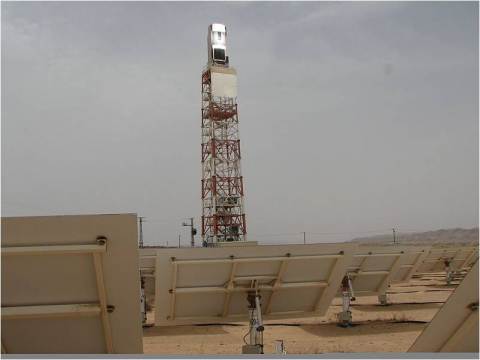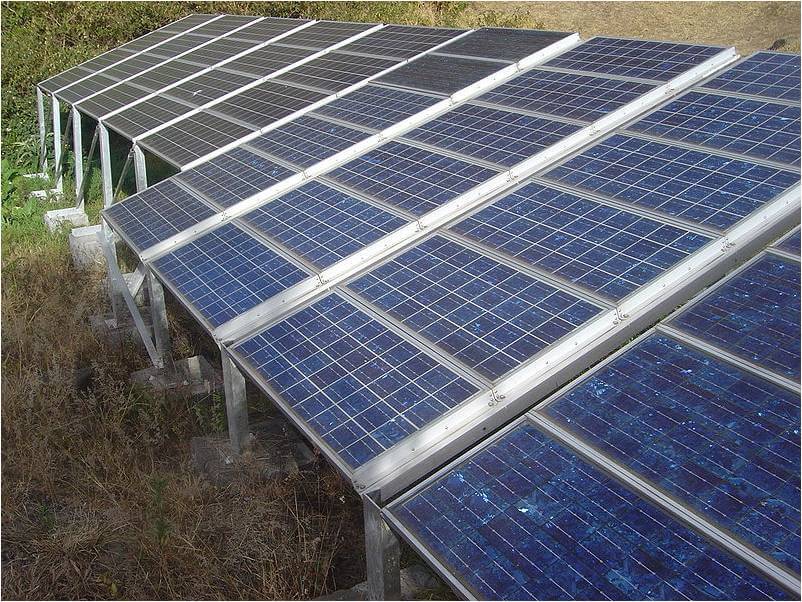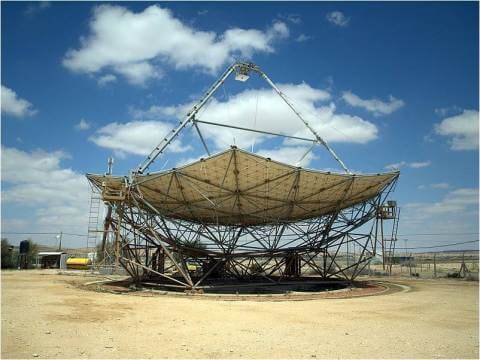I met with Gideon Segev to ask him what they are doing there at the university.

A solar tower and mirrors that direct the light to it at the SEDC site in the Rotem Industrial Park. Source: Wikipedia.
Gideon is married to Orit and for about a month (at the time of the conversation) is a new father to his eldest daughter Carmel. They both really like to travel and play basketball, although lately it's a bit difficult for them to find free time. He earned his bachelor's degree at Ben-Gurion University of the Negev and is currently doing his doctoral thesis at the Faculty of Engineering at Tel Aviv University, under the guidance of Prof. Avi Kribus from the Department of Mechanical Engineering and Prof. Yossi Rosenox from the Department of Electrical Engineering. His main interest is in the question of how to utilize solar energy for the efficient production of electricity.
Gideon, so what are you doing there?
Well, first you have to understand that the goal of every researcher in our field is to find ways to make generating electricity from solar energy cheaper than generating electricity from coal. It should also be understood that today it is not possible to fully transfer electricity production to the use of renewable energy because there is a problem of storage. Today's energy storage capabilities (referring to batteries and the like) are still not good enough. However, today it is possible to build a solar farm that can provide 20-30% of the national electricity consumption at certain times when we need it, for example on a hot summer day when all the air conditioners are on.
I also wanted to clarify that solar energy cannot be used as a substitute for fuel in cars, and will not solve the problem of fuel prices. At least as long as the cars are not all electric. The goal is to try to replace some of the coal-fired power plants.
Okay, tell me how you turn solar energy into electricity
There are two main methods of converting solar energy into electricity, the first is related to heat and the second is related to light.
Some of us probably remember that as children we would use a magnifying glass to burn things. Similarly, the first method is to concentrate the sunlight to one hot spot (with the help of lenses or mirrors) where we heat a liquid so that steam is created. The steam will turn a turbine similar to a normal power plant and thus generate electricity. Such a power plant is called a thermo-solar plant.
There are already pilot stations in Israel, for example BrightSource near Dimona and Aora near Kibbutz Samar in Arava.

The second method is called photovoltaic conversion. These are special devices in which the received light is directly converted into electricity without further conversion along the way. These devices are built by connecting two different materials between which an electric field is created due to the connection. Most often (but not always) it is two pieces of silicone that differ in the type of additional materials inserted into the content. When the light hits the silicon it causes the release of electrons. These freed electrons will move following the internal electric field in a constant direction and thus we can get a current. There are electrical components that will convert the direct current into alternating current and adapt it to the home electrical network.
What are the topics that interest researchers in the field?
Solar cell research can be divided into two main schools of thought. The researchers in the first school try to produce the best possible cell, so that the same cell can generate more electricity. The researchers in the second school are not interested in the most efficient cells but in the development of the cheapest cells. Each school of thought dictates the search for the materials and production processes suitable for it.
The price of very high quality cells (first school) is usually correspondingly high, so we would like to use them to the maximum. For this purpose it is advisable to use radiation concentration by lenses or mirrors. That is, we will make sure that a very large amount of sunlight reaches each cell. The direct gain is that we will need a lower number of cells. For this reason, many researchers are engaged in the optimization of radiation concentration systems for solar cells. The cells must be cooled so as not to lose the high efficiency.
Wait, wait, what is utility?
The efficiency answers the question: what part of the light that enters the cell is converted into electricity. The accepted estimate in Israel is that on a sunny day you get a kilowatt of light radiation per square meter. So for example a cell measuring one meter by one meter and having an efficiency of 20 percent will produce about 200 watts. A standard silicon cell sold to the consumer typically has an efficiency of about 15%. The best silicon cell built to date reached 24% efficiency. The record today is a special cell (not a normal silicon cell) in which, under certain laboratory conditions*, an efficiency of 43% was measured, but these cells are very expensive and are currently used mainly for satellites.
What are you working on these days?

At university we are usually looking for the next thing in the field. One of the projects we are working on deals with finding new and more efficient ways than the ones I talked about to convert solar energy into electricity. This project is not actually about a photovoltaic cell. It is a device consisting of two plates, one metallic and one semiconductor, with a vacuum between them. One of the plates is heated and the other is kept at a temperature as low as possible. The light radiation hitting the hot plate causes the release of an electron in a process called thermionic emission. Between the two plates there is an electric field that makes sure that the emitted electron reaches the other plate and thus a current is created. Also, it turns out that the more you heat and irradiate this device with a higher intensity, the more efficiently it works. About two years ago, an article was published in the journal Nature materials that showed that the radiation hitting the board significantly increases the rate of electron emission.
From the calculations we made, we came to the conclusion that radiation can be concentrated on this device so that it reaches the desired temperature and receives enough light. In this situation, we showed that it is possible, theoretically, to reach an efficiency higher than 40 percent! In addition, since the cell is at a very high temperature (several hundred degrees Celsius on the cold plate), we can use it in a similar way to a thermo-solar system.
Sounds ideal, have the world's energy problems been solved?
Not yet. First, the theory must continue to be developed because it is still not as consolidated as we would like. A second thing that is very important to note is that such a system has actually never been built. One of the next steps of the project will be to build a system with which we can show that the theoretical ideas can be implemented in reality. Building such a system contains many and varied challenges. Once we overcome them we may be able to present to the world a new and more efficient way to 'harvest' the sun's energy.
* Update from 11.06.12
--------------------------
I would be happy to meet and talk with any research student (maybe you?) who is willing to participate and tell me a little about what he is doing (and all for the price of a not too long conversation). You can contact me via Contact Us Form.
It's time to tell everyone what you're doing, maybe this time they'll understand too 🙂

5 תגובות
Before they start producing on a large scale even with an efficiency of 10%!
After that, the methods can be perfected and a better efficiency can be reached.
I wonder what the reaction of the electric company will be.
Regarding the storage of electrical energy.
No need to store at all!
During the day they will generate electricity from solar energy and use the electricity immediately without storage.
At night they will produce electricity from fossil energy as has been customary until today.
I'll give you an idea and remember I was the first.
You will do the conductor/semiconductor (thermo solar) method in the Dead Sea using the huge temperature differences of the salt layers.
*enjoyable
Agree with Or. It was definitely an answer and interesting to read. Hope you write more things
It's just fun to read, I've always wondered how photovoltaic cells work and now I'm amazed.